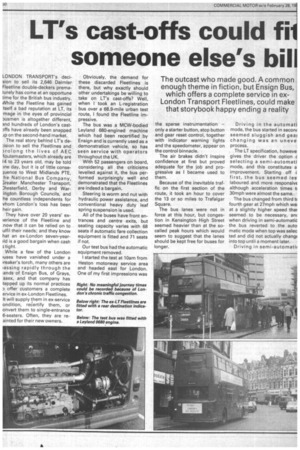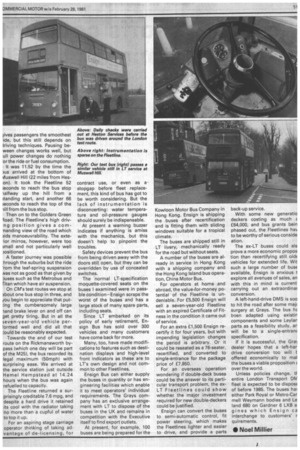LT's cast-offs could fl someone else's bil
Page 52

Page 53

If you've noticed an error in this article please click here to report it so we can fix it.
LONDON TRANSPORT's decision to sell its 2,646 Daimler Fleetline double-deckers prematurely has come at an opportune time for the British bus industry. Aihile the Fleetline has gained tself a bad reputation at LT, its mage in the eyes of provincial Dusmen is altogether different, nd hundreds of London's cast)ffs have already been snapped Ap on the second-hand market.
The real story behind LT's de;ision to sell the Fleetlines and )rolong the lives of AEC 3outemasters, which already are 14 to 23 years old, may be told )ne day, but it is of little conseluence to West Midlands PTE, he National Bus Company, l'reater Manchester Transport, hesterfield, Derby and Warington Borough Councils, and he countless independents for vhom London's loss has been heir gain.
They have over 20 years' ex)erience of the Fleetline and now that it can be relied on to ulfil their needs; and they know hat an ex-London seven-year
Id is a good bargain when cash 3 tight.
While a few of the London iuses have vanished under a ireaker's torch, many others are lassing rapidly through the ands of Ensign Bus, of Grays, ssex, and that company has tepped up its normal practices offer customers a complete ervice in ex-London Fleetlines. It will supply them in ex-service ondition, recertify them, or onvert them to single-entrance 6-seaters. Often, they are reainted for their new owners. Obviously, the demand for these discarded Fleetlines is there, but why exactly should other undertakings be willing to take on LT's cast-offs? Well, when I took an L-registration bus over a 68.9-mile urban test route, I found the Fleetline impressive.
The bus was a MCW-bodied Leyland 680-engined machine which had been recertified by Ensign and is currently used as a demonstration vehicle, so has seen service with operators throughout the UK.
With 52 passengers on board, considering all the criticisms levelled against it, the bus performed surprisingly well and demonstrated that the Fleetlines are indeed a bargain.
Steering is worm and nut with hydraulic power assistance, and conventional heavy duty leaf spring suspension is used.
All of the buses have front entrances and centre exits, but seating capacity varies with 68 seats if automatic fare collection equipment is fitted and 71 seats if not.
Our test bus had the automatic equipment removed.
I started the test at 10am from Heston motorway service area and headed east for London.
One of my first impressions was the sparse instrumentation — only a starter button, stop button and gear reset control, together with indicator warning lights and the speedometer, appear on the control binnacle.
The air brakes didn't inspire confidence at first but proved adequate for the job and progressive as I became used to them.
Because of the inevitable traffic on the first section of the route, it took an hour to cover the 13 or so miles to Trafalgar Square.
The bus lanes were not in force at this hour, but congestion in Kensington High Street seemed heavier than at the socalled peak hours which would seem to suggest that the lanes should be kept free for buses for longer. Driving in the automati mode, the bus started in secon( seemed sluggish and gear changing was an uneve process.
The LT specification, howeve gives the driver the option c selecting a semi-automati mode, and this constitutes a improvement. Starting off i first, the bus seemed les laboured and more responsive although acceleration times ti 30mph were almost the same.
The bus changed from third t( fourth gear at 27mph which wai at a slightly higher speed that seemed to be necessary, an when driving in semi-automatic the bus reverted to the auto matic mode when top was selec ted and did not actually chang( into top until a moment later.
Driving in semi-automatic lives passengers the smoothest ide, but this still depends on iriving techniques. Pausing beween changes works well, but ull power changes do nothing or the ride or fuel consumption.
It was 11.52 by the time the xis arrived at the bottom of Vluswell Hill (22 miles from Heson). It took the Fleetline 52 seconds to reach the bus stop lalfway up the hill from a standing start, and another 66 seconds to reach the top of the lin from the bus stop.
Then on to the Golders Green 3oad. The Fleetline's high drivng position gives a corn-nanding view of the road which ;ids manoeuvrability. The exteior mirros, however, were too ;mall and not particularly well Jositioned.
A faster journey was possible hrough the suburbs but the ride 'ram the leaf-spring suspension as not as good as that given by Duses such as the Metrobus and Man which have air suspension.
On CM's test routes we stop at lbout one bus stop in three, and (ou begin to appreciate that put:ing the cumbersomely large land brake lever on and off can get pretty tiring. But in all the 3even-year-old vehicle per5;)rrned well and did all that z'ould be reasonably expected.
Towards the end of our test route on the Rickmansworth bypass (which one day will be part of the M25), the bus recorded its legal maximum (50mph) with surprising ease. We arrived at the service station just outside Hemel Hempstead at 14.24 hours when the bus was again refuelled to capacity.
The Fleetline returned a surprisingly creditable 7.6 mpg, and despite a hard drive it retained its cool with the radiator taking no more than a cupful of water to top it up.
For an aspiring stage carriage operator thinking of taking advantage of de-licensing, for contract use, or even as a stopgap before fleet replacement, this kind of bus has got to be worth considering. But the lack of instrumentation is disconcerting: water temperature and oil-pressure gauges should surely be indispensable.
At present a warning buzzer indicates if anything is amiss with the mechanics, but this doesn't help to pinpoint the troubles.
Safety devices prevent the bus from being driven away with the doors still open, but they can be overridden by use of concealed switches.
The normal LT-specification moquette-covered seats on the buses I examined were in passble condition—Ensign scraps the worst of the buses and has a large stock of many spare parts, including seats.
Since LT embarked on its policy of early retirement, Ensign Bus has sold over 300 vehicles and many customers have come back for more.
Many, too, have made modifications to features such as desti nation displays and high-level front indicators as these are to LT's own design and not common to other Fleetlines.
Ensign Bus can either supply the buses in quantity or has engineering facilities which enable it to meet operators' individual requirements. The Grays com pany has an exclusive arrangement with LT to dispose of the buses in the UK and remains in competition with the Executive itself to find export outlets.
At present, for example, 100 buses are being prepared for the Kowloon Motor Bus Company in Hong Kong. Ensign is shipping the buses after recertification and is fitting them with sliding windows suitable for a tropical climate.
The buses are shipped still in LT livery, mechanically ready for the road but without seats.
A number of the buses are already in service in Hong Kong with a shipping company and the Hong Kong Island bus operation, China Motor Bus.
For operators at home and abroad, the value-for-money potential of the Fleetline is undeniable. For E5,500 Ensign will sell a seven-year-old Fleetline with an expired Certificate of Fitness in the condition it came out of service.
For an extra £1,500 Ensign recertify it for four years, but with impending legislation changes the period is arbitrary. Or it could be reseated as a 76-seater, recertified, and converted to single-entrance for the package price of £7,850.
For an overseas operation wondering if double-deck buses could be the answer to its particular transport problem, the exLT Fleetlines could show whether the major investment required for new double-deckers could be justified.
Ensign can convert the buses to semi-automatic control, fit power steering, which makes the Fleetlines lighter and easier to drive, and provide a parts back-up service.
With some new generatio deckers costing as much E. £64,000, and bus grants bein phased out, the Fleetlines ha% to be worthy of serious conside ation.
The ex-LT buses could als prove a more economic propos tion than recertifying still oldE vehicles for extended life. Wit such a large number of bus€ available, Ensign is anxious t explore all avenues of sales, an with this in mind is current carrying out an extraordinar conversion.
A left-hand-drive DMS is soo to hit the road after some majc surgery at Grays. The bus hE been adapted using existir components and some Leylar parts as a feasibility study, ar will be to a single-entranc specification.
If it is successful, the Gra) dealer hopes that a left-har drive conversion too will t offered economically to mal the buses a viable proposition E over the world.
Unless policies change, tt entire London Transport DIV fleet is expected to be disposE of before 1985. The buses ha) either Park Royal or Metro-Car mell Weymann bodies and Le land 680 on Gardner 6 LXB e gines which Ensign ca interchange to customers' r quirements.
• Noel Millier




























































































